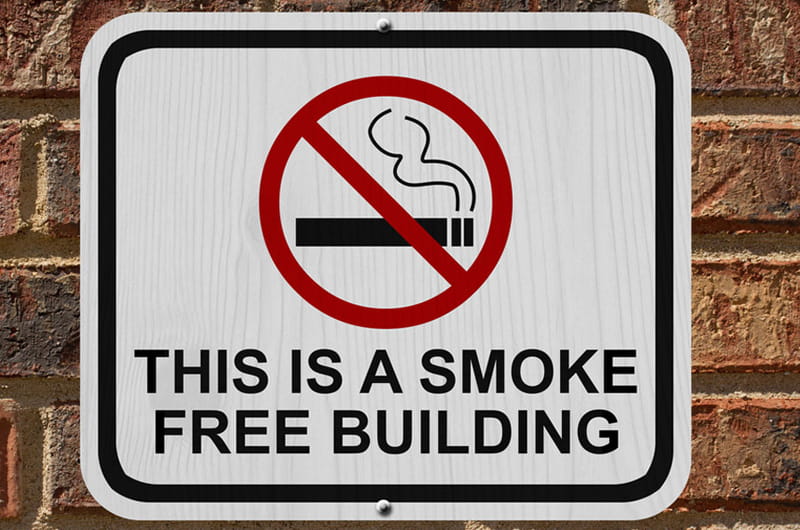Smoke-Free Policy Cuts Nicotine Detected in Philadelphia Public Housing in Half: Study
 By Frank Otto
By Frank Otto

- Drexel Environmental Collaboratory Releases Cross-Sector Findings on Severe Weather Recovery Challenges
- Drexel Launches the Manuel Stamatakis Center for Alternative Investments at the LeBow College of Business
- How and When Could AI Be Used in Emergency Medicine?
- Faculty Highlights: Recent Awards and Grants

Philadelphia’s public housing residents are breathing in less secondhand smoke since a 2015 comprehensive smoke-free policy went into place, a new study indicates.
Ann Klassen, PhD, a professor in Drexel University’s Dornsife School of Public Health, led the study that monitored nicotine levels in Philadelphia Housing Authority properties both before and after the smoke-free policy was implemented. Klassen and her team found that although the number of places where nicotine was detected remained unchanged, the levels of detected nicotine were reduced by almost half after the policy was enacted.
“This is encouraging,” Klassen said. “These data show a reduction in exposure to airborne nicotine, which is an indicator of reduced exposure to secondhand smoke, and, therefore, healthier air in multi-unit housing.”
With the federal Department of Housing and Urban Development (HUD) now requiring all public housing authorities across the U.S. to implement smoke-free policies by 2018, these findings from Philadelphia are a timely look at what could be accomplished.
For their study, set to be published in Tobacco Regulatory Science, Klassen, Drexel epidemiologist Nora Lee, PhD, and colleagues partnered with the Philadelphia Housing Authority and Philadelphia Department of Health, as well as the Second Hand Smoke Exposure Assessment Laboratory at Johns Hopkins University. The Philadelphia Housing Authority is the largest in the country to implement a fully smoke-free policy in their properties. The policy, approved in July, 2015, was developed by Philadelphia Housing Authority leadership in partnership with PHA residents, with technical support from the Philadelphia Department of Public Health, including on-site cessation services provided through the Health Federation of Philadelphia and National Nurse-Led Care Consortium.
Prior to the new policy, smoking was not permitted in public areas, but was allowed inside individual homes. However, there was concern about how secondhand smoke drifted in these properties and how much they affected common areas, like hallways, laundry room and elevators, and non-smoking households. In multi-unit housing, as much as 60% of air is transferred between units
To measure potential secondhand smoke exposure, the team placed monitors throughout four different communities, ranging from high-rise apartment complexes to rowhomes, to capture nicotine in the air. Airborne nicotine was measured in common areas, where the average nicotine level was found to be significantly reduced (from 0.44 micrograms per cubic meter in 2013 to 0.23 in 2016). Inside non-smoking residents’ homes, trends toward reduced nicotine exposures were also seen.
These findings confirm that community-wide smoke-free policies are more effective in reducing secondhand smoke exposures for all residents than policies that permit smoking inside individual residences. This is very important in public housing communities, which include a variety of residents, including children, elderly, and chronically ill residents, who are especially vulnerable to respiratory diseases, like asthma.
Klassen’s study took readings from monitors in 2013, 2014 and 2016, but she supports continuing assessment. “For all new policies, it is very important to continue to monitor implementation over time and support consistent improvements,” Klassen said. “Sustainable change takes long-term commitment, but this is a strong start.”
Programming could strengthen that start and continue progress.
“Cessation and education services are an ongoing need all communities, as successful cessation takes time and support,” Klassen explained. “In addition, environmental education — how secondhand smoke travels and how it remains over time — is a great interest for residents. We found that both smokers and non-smokers are truly interested in learning about how to protect the health of their families and communities.”
This project was made possible in part by funding from the Centers for Disease Control and Prevention, Philadelphia General Funds, and Pennsylvania Department of Health (PADOH) and its Master Settlement Agreement funding to the Philadelphia Department of Public Health (PDPH). Dornsife School of Public Health alumni and students Aaron Pankiewicz, MPH ’11, Rikki Ward, MPH ’14, Michelle Shuster, MPH ’14, Bethany Townsend Ogbenna, MPH ’15, Olufunlayo Osayameh, MPH ’16, Anita Wade, MPH-candidate ’17, and Maxwell Boamah, MPH-candidate ’17 co-authored the study.
The full study, “SHS Exposure and Smoke-Free Policy in Philadelphia Public Housing,” will be published in Tobacco Regulatory Science’s April issue.
In This Article
Contact
Drexel News is produced by
University Marketing and Communications.